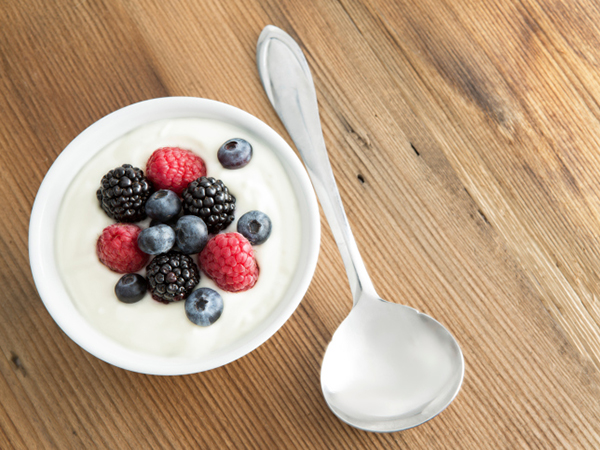What is cool, creamy and delicious? Yogurt! Even better, it is a great part of a healthy diet for kids and adults. Yogurt is rich in protein and contains calcium and potassium. Some yogurts contain live, active bacteria cultures, as indicated on the label. These cultures, or probiotics, are considered "good bacteria" for the gut and can help maintain healthy digestive systems.
Yogurt comes in an array of flavors and styles. On a single trip to the supermarket, a shopper could easily see more than a dozen different brands with multiple varieties of each.
Between low-fat, fat-free, fruited, flavored, plain, Greek and traditional — the choices can be overwhelming.

What Kind of Yogurt to Buy?
- Whole Milk, Low-Fat or Fat-Free? Overall, it is best to choose low-fat or fat-free yogurt as recommended by the Dietary Guidelines for Americans and MyPlate. There are many delicious low-fat and fat-free options to choose from.
- Fruited, Flavored or Plain? Added sugar is a common ingredient in fruited and flavored varieties of yogurt. Skip the added sugars by choosing plain yogurt and adding your own fruit or flavors such as cinnamon and vanilla. When you read the Nutrition Facts label on plain yogurt, you still will see that it lists "sugar" even though no sugar has been added. This is because even plain yogurt contains lactose, the naturally occurring sugar in milk.
- Greek Yogurt or Traditional Yogurt? Greek yogurt is strained. This process makes it thicker, creamier and smoother than traditional yogurt. It also has double the protein of traditional yogurt, but reduced calcium. In both traditional and Greek yogurts, bacteria cultures help break down lactose, so yogurt is sometimes an easier dairy food to digest for those who are lactose intolerant. Greek yogurt has less lactose than traditional yogurt, so lactose-sensitive individuals may tolerate it even better than traditional yogurt.
- Dairy or plant-based? Whether you cannot or choose not to consume dairy, the good news is there are loads of plant-based dairy alternatives on the market. Be sure to look for versions that are fortified with calcium and vitamin D. Fortified soy-based yogurt has the closest nutrition profile to dairy-based yogurt while coconut milk and almond milk varieties are lower in protein.
I bought yogurt. Now what?
- Dip it. Have fun in the kitchen with your child by using yogurt as a dip for a variety of different fruits. For a healthier alternative to a typical cream cheese based fruit dip, stir together 1 cup non-fat Greek yogurt with 1 teaspoon cinnamon and 1 teaspoon vanilla extract.
- Sweeten it. While all yogurt has some natural sugar, take care to choose yogurts that are low in added sugars or have no added sugars. The Dietary Guidelines for Americans recommends limiting calories from added sugars to no more than 10% each day, which is equal to 200 calories for a 2,000-calorie diet. Fresh or frozen fruits can flavor yogurt or try using cinnamon or a sugar substitute. Additionally, you can sweeten yogurt using honey (for children over the age of 1 year) but be mindful that it is considered an added sugar.
- Mix it. Start the morning off right by including yogurt at breakfast. Mix a 6-ounce container of low-fat yogurt with ½ cup sliced berries, a handful of granola and 2 tablespoons nuts for a quick and satisfying breakfast bowl.
- Blend it. Blend up a calcium-packed snack using this yogurt smoothie recipe: 1 6-ounce container low-fat yogurt, ¾ cup low-fat milk, ½ cup frozen strawberries, ½ cup frozen blueberries, 1 banana, 1 teaspoon cinnamon and 1 teaspoon vanilla extract. Then, mix it all together using a blender. Depending on your family's tastes, you also can offer nut butters, vegetables, seeds or other nutritious add-ins.
- Drink it. Have your children drink their bones strong with homemade yogurt beverages. Make your own by whisking together a 6-ounce container of low-fat strawberry-flavored yogurt and ¼ cup low-fat milk. Pour the mixture into cups and enjoy. If there's too much liquid, add more yogurt; if the mixture is too thick, add more milk.
- Spoon it. Spoon in a delicious topping for your next taco night with plain yogurt. Use ½ cup plain low-fat Greek yogurt, 2 teaspoons taco seasoning and 1 teaspoon lime juice for a fun alternative to sour cream. And that's not all: plain yogurt is a versatile ingredient and often can be substituted for sour cream in recipes.
- Dunk it. Dunk in the yogurt fun — and build kitchen skill confidence — with banana-yogurt-granola pops. Use half a banana with a popsicle stick placed in the bottom. Have your child dunk the banana in low-fat yogurt, roll in granola and enjoy!
How Much of a Good Thing?
One cup of dairy-based fat-free or low-fat yogurt provides 30 to 45% of the daily value for calcium, so you can get a lot of nutritional bang for your buck. If you are using frozen yogurt, 1 cup provides about 10% of the daily value for calcium. Remember to look for fortified varieties if you're choosing plant-based alternatives. Fortified soy-based yogurt has the closest nutrition profile to dairy-based yogurt. Be sure to look for versions that are fortified with calcium and vitamin D.
One cup dairy-based yogurt or fortified plant-based yogurt counts as one of the three dairy servings recommended for children 10 years old through adulthood by MyPlate. For toddlers (12 to 23 months of age), 1 ⅔ to 2 cups of dairy are recommended daily. For children 2 to 3 years old, it is 2 to 2½ cups per day. For children 4 to 8 years old, 2 ½ cups per day of dairy is recommended, and 3 cups daily for children nine and older
Find a Nutrition Expert
Looking for credible nutrition information and recommendations? The Academy of Nutrition and Dietetics' network of credentialed food and nutrition practitioners are ready to help!
